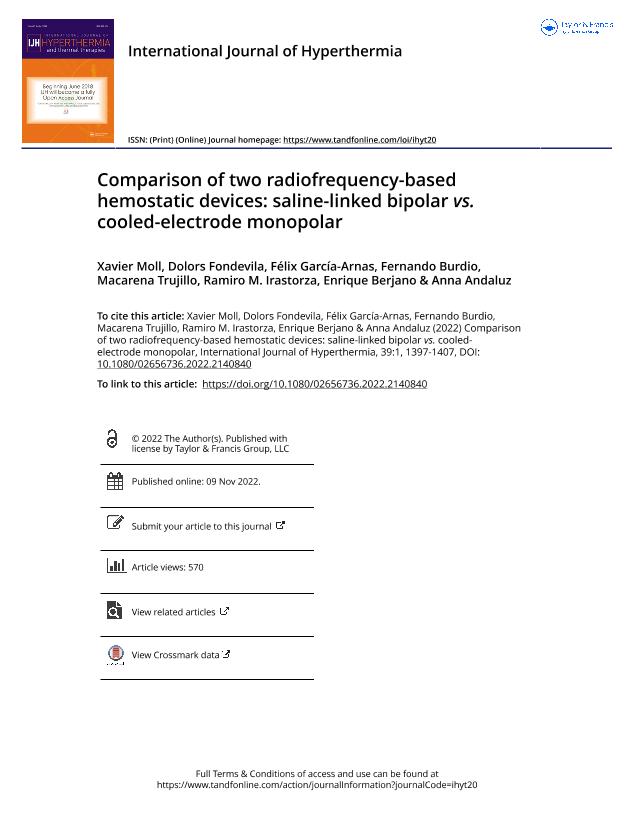Mostrar el registro sencillo del ítem
dc.contributor.author
Moll, Xavier
dc.contributor.author
Fondevila, Dolors
dc.contributor.author
García Arnas, Félix
dc.contributor.author
Burdio, Fernando
dc.contributor.author
Trujillo, Macarena
dc.contributor.author
Irastorza, Ramiro Miguel

dc.contributor.author
Berjano, Enrique
dc.contributor.author
Andaluz, Anna
dc.date.available
2023-09-22T12:13:54Z
dc.date.issued
2022-11
dc.identifier.citation
Moll, Xavier; Fondevila, Dolors; García Arnas, Félix; Burdio, Fernando; Trujillo, Macarena; et al.; Comparison of two radiofrequency-based hemostatic devices: saline-linked bipolar vs. cooled-electrode monopolar; Informa Healthcare; International Journal Of Hyperthermia; 39; 1; 11-2022; 1397-1407
dc.identifier.issn
0265-6736
dc.identifier.uri
http://hdl.handle.net/11336/212647
dc.description.abstract
Purpose: To characterize the coagulation zones created by two radiofrequency (RF)-based hemostatic devices: one comprised an internally cooled monopolar electrode and the other comprised externally irrigated bipolar electrodes (saline-linked). Materials and methods: RF-induced coagulation zones were created on ex vivo and in vivo porcine models. Computer modeling was used to determine the RF power distribution in the saline-linked device. Results: Both external (irrigation) and internal cooling effectively prevented tissue sticking. Under ex vivo conditions in ‘painting’ application mode, coagulation depth increased with the applied power: 2.8 − 5.6 mm with the 3-mm monopolar electrode, 1.6 − 6.0 mm with the 5-mm monopolar electrode and 0.6 − 3.2 mm with the saline-linked bipolar electrodes. Under in vivo conditions and using spot applications, the 3-mm monopolar electrode created coagulation zones of similar depth to the saline-linked bipolar electrodes (around 3 mm), while the 5-mm monopolar electrode created deeper coagulations (4.5 − 6 mm) with less incidence of popping. The presence of saline around the saline-linked bipolar electrodes meant that a significant percentage of RF power (50 − 80%) was dissipated by heating in the saline layer. Coagulation zones were histologically similar for all the tested devices. Conclusions: Both external (irrigation) and internal cooling in hemostatic RF devices effectively prevent tissue sticking and create similar coagulation zones from a histological point of view. Overall, saline-linked bipolar electrodes tend to create shallower coagulations than those created with an internally cooled monopolar electrode.
dc.format
application/pdf
dc.language.iso
eng
dc.publisher
Informa Healthcare

dc.rights
info:eu-repo/semantics/openAccess
dc.rights.uri
https://creativecommons.org/licenses/by-nc-sa/2.5/ar/
dc.subject
COOLED ELECTRODE
dc.subject
HEMOSTATIC DEVICE
dc.subject
RADIOFREQUENCY
dc.subject
SALINE-LINKED
dc.subject
THERMAL ABLATION
dc.subject.classification
Otras Ingeniería Eléctrica, Ingeniería Electrónica e Ingeniería de la Información

dc.subject.classification
Ingeniería Eléctrica, Ingeniería Electrónica e Ingeniería de la Información

dc.subject.classification
INGENIERÍAS Y TECNOLOGÍAS

dc.title
Comparison of two radiofrequency-based hemostatic devices: saline-linked bipolar vs. cooled-electrode monopolar
dc.type
info:eu-repo/semantics/article
dc.type
info:ar-repo/semantics/artículo
dc.type
info:eu-repo/semantics/publishedVersion
dc.date.updated
2023-06-29T10:27:09Z
dc.journal.volume
39
dc.journal.number
1
dc.journal.pagination
1397-1407
dc.journal.pais
Reino Unido

dc.journal.ciudad
Londres
dc.description.fil
Fil: Moll, Xavier. Universitat Autònoma de Barcelona; España
dc.description.fil
Fil: Fondevila, Dolors. Universitat Autònoma de Barcelona; España
dc.description.fil
Fil: García Arnas, Félix. Universitat Autònoma de Barcelona; España
dc.description.fil
Fil: Burdio, Fernando. Hospital del Mar; España
dc.description.fil
Fil: Trujillo, Macarena. Universidad Politécnica de Valencia; España
dc.description.fil
Fil: Irastorza, Ramiro Miguel. Universidad Tecnológica Nacional; Argentina. Consejo Nacional de Investigaciones Científicas y Técnicas. Centro Científico Tecnológico Conicet - La Plata. Instituto de Física de Líquidos y Sistemas Biológicos. Universidad Nacional de La Plata. Facultad de Ciencias Exactas. Instituto de Física de Líquidos y Sistemas Biológicos; Argentina
dc.description.fil
Fil: Berjano, Enrique. Universidad Politécnica de Valencia; España
dc.description.fil
Fil: Andaluz, Anna. Universitat Autònoma de Barcelona; España
dc.journal.title
International Journal Of Hyperthermia

dc.relation.alternativeid
info:eu-repo/semantics/altIdentifier/doi/http://dx.doi.org/10.1080/02656736.2022.2140840
dc.relation.alternativeid
info:eu-repo/semantics/altIdentifier/url/https://www.tandfonline.com/doi/full/10.1080/02656736.2022.2140840
Archivos asociados
